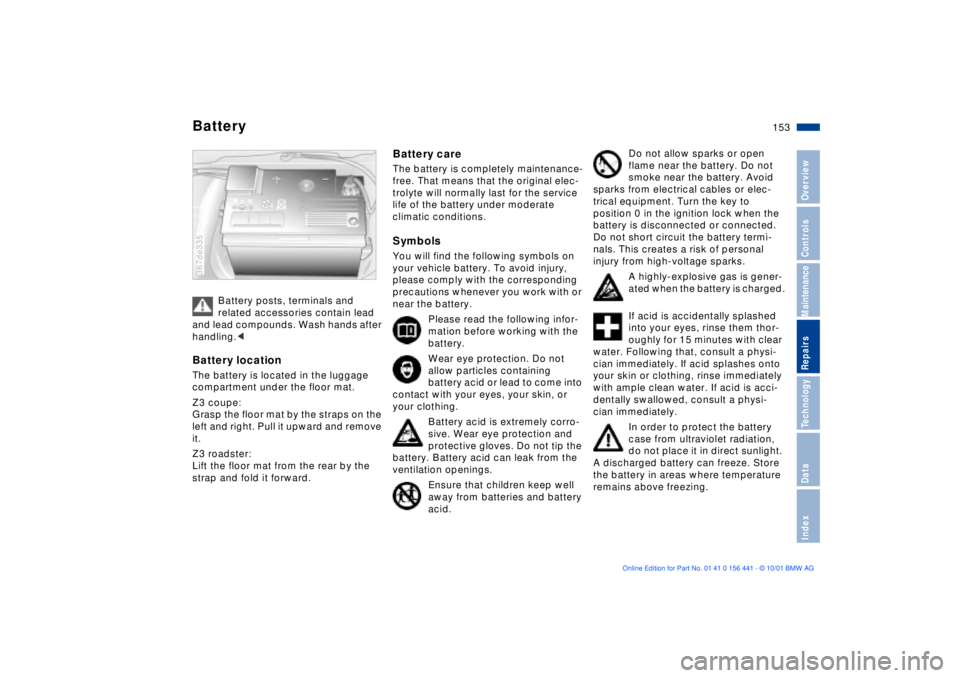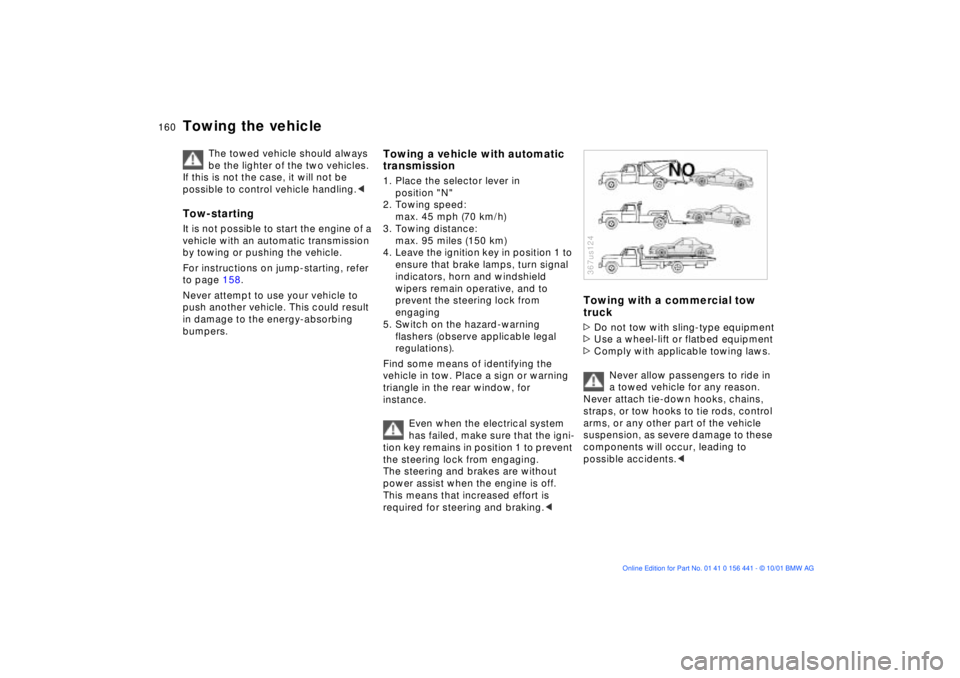Page 153 of 187

153n
IndexDataTechnologyRepairsMaintenanceControlsOverview
Battery
Battery posts, terminals and
related accessories contain lead
and lead compounds. Wash hands after
handling.<
Battery locationThe battery is located in the luggage
compartment under the floor mat.
Z3 coupe:
Grasp the floor mat by the straps on the
left and right. Pull it upward and remove
it.
Z3 roadster:
Lift the floor mat from the rear by the
strap and fold it forward.367de335
Z3 d Z3
Battery careThe battery is completely maintenance-
free. That means that the original elec-
trolyte will normally last for the service
life of the battery under moderate
climatic conditions.SymbolsYou will find the following symbols on
your vehicle battery. To avoid injury,
please comply with the corresponding
precautions whenever you work with or
near the battery.
Please read the following infor-
mation before working with the
battery.
Wear eye protection. Do not
allow particles containing
battery acid or lead to come into
contact with your eyes, your skin, or
your clothing.
Battery acid is extremely corro-
sive. Wear eye protection and
protective gloves. Do not tip the
battery. Battery acid can leak from the
ventilation openings.
Ensure that children keep well
away from batteries and battery
acid.
Do not allow sparks or open
flame near the battery. Do not
smoke near the battery. Avoid
sparks from electrical cables or elec-
trical equipment. Turn the key to
position 0 in the ignition lock when the
battery is disconnected or connected.
Do not short circuit the battery termi-
nals. This creates a risk of personal
injury from high-voltage sparks.
A highly-explosive gas is gener-
ated when the battery is charged.
If acid is accidentally splashed
into your eyes, rinse them thor-
oughly for 15 minutes with clear
water. Following that, consult a physi-
cian immediately. If acid splashes onto
your skin or clothing, rinse immediately
with ample clean water. If acid is acci-
dentally swallowed, consult a physi-
cian immediately.
In order to protect the battery
case from ultraviolet radiation,
do not place it in direct sunlight.
A discharged battery can freeze. Store
the battery in areas where temperature
remains above freezing.
Page 160 of 187

160n
Towing the vehicle
The towed vehicle should always
be the lighter of the two vehicles.
If this is not the case, it will not be
possible to control vehicle handling.<
Tow-startingIt is not possible to start the engine of a
vehicle with an automatic transmission
by towing or pushing the vehicle.
For instructions on jump-starting, refer
to page 158.
Never attempt to use your vehicle to
push another vehicle. This could result
in damage to the energy-absorbing
bumpers.
Towing a vehicle with automatic
transmission1. Place the selector lever in
position "N"
2. Towing speed:
max. 45 mph (70 km/h)
3. Towing distance:
max. 95 miles (150 km)
4. Leave the ignition key in position 1 to
ensure that brake lamps, turn signal
indicators, horn and windshield
wipers remain operative, and to
prevent the steering lock from
engaging
5. Switch on the hazard-warning
flashers (observe applicable legal
regulations).
Find some means of identifying the
vehicle in tow. Place a sign or warning
triangle in the rear window, for
instance.
Even when the electrical system
has failed, make sure that the igni-
tion key remains in position 1 to prevent
the steering lock from engaging.
The steering and brakes are without
power assist when the engine is off.
This means that increased effort is
required for steering and braking.<
Towing with a commercial tow
truck>Do not tow with sling-type equipment
>Use a wheel-lift or flatbed equipment
>Comply with applicable towing laws.
Never allow passengers to ride in
a towed vehicle for any reason.
Never attach tie-down hooks, chains,
straps, or tow hooks to tie rods, control
arms, or any other part of the vehicle
suspension, as severe damage to these
components will occur, leading to
possible accidents.< 367us124
Page 165 of 187

165n
IndexDataTechnologyRepairsMaintenanceControlsOverview
The airbags located under the marked
covers inflate and unfold in a matter of
a few milliseconds. In this process they
tear through the designed breaking
points of the upholstered covers or
press them out.
Because the inflation process must be
virtually instantaneous, it is necessarily
accompanied by a certain amount of
ignition and inflation noise. The gas
required to inflate the airbags is not
dangerous, and it dissipates together
with the associated smoke.
The entire process is completed within
fractions of a second.Precision sensors monitor the number of
revolutions of the wheels. When
equipped with DSC, they also monitor
steering angle, lateral acceleration,
brake pressure and the movement of the
vehicle around its vertical axis.
If differences in the wheel speeds occur,
ASC+T recognizes the danger of wheel-
spin and reduces the drive torque. If
necessary, the system also responds
with additional applications of the brakes
at the rear wheels.
In addition, DSC permanently monitors
the vehicle's current operating condition
and compares it with an ideal condition
that is calculated from the sensor's
signals. If deviations from this occur
(understeering or oversteering, for
instance), DSC can stabilize the vehicle
in fractions of a second by adjusting
engine output and with the assistance of
braking intervention at individual wheels.
Within physically possible limits
dangerous skids can be prevented even
as they are just beginning.You may need some time to become
accustomed to this system's interven-
tion. However, it provides optimum
propulsive force and driving stability.
The braking intervention may be accom-
panied by a certain degree of noise.Airbags ASC+T/DSC
*
Page 174 of 187
174n
Electrical system Drive belts Battery12V, 70 AhSpark plugsNGK BKR 6 EQUP
This spark ignition system meets all
requirements of the Canadian Interfer-
ence-Causing Equipment Regulations
(ICES-2).Generator Ð Water pump Ð
Power steering
Drive belt 6 PK x 1538
A/C compressor
Drive belt 5 PK x 863You can obtain Original BMW
parts and accessories, as well as
professional advice from your BMW
center.<
Page 181 of 187

Everything from A to Z
181n
IndexDataTechnologyRepairsMaintenanceControlsOverview
Heated seats89
Heating and
ventilation80, 84
Heat-up, rapid83
Height171
Height adjustment, seats49
Help with jump starting158
High beams23, 64
bulb replacement137t
High Performance Synthetic
Oil124
High-mount brake lamp
(center)141
Hood release118t
Horn17
Hub cover150
Hydraulic brake assistant,
refer to DBCIIce warning71
Identification number of the
vehicle127
Identification, tires114
Ignition key30
Ignition switch58
Immobilizer, electronic31
Immobilizer, vehicle31Imprint4
Indicator lamps20
Inflation
pressures26t, 110
Inflation pressures,
tires26t
INSPECTION69
Instrument panel16
lighting76
Instruments18
Interface socket for onboard
diagnostics (OBD)133
Interior lamps77
bulb replacement142t
Interlock58
Intermittent wipe switch65
JJack146t
Jump-starting158tKKeys30
Keys with remote
control30, 33
Key, battery change143t
Kickdown63
LLamp switch76
Lashing eyes94
Leather care, refer to the
"Caring for your vehicle"
manual
Length171
License plate lamps
bulb replacement141t
Light-alloy wheel116
LIGHTS ON warning76
Limited slip differential166
Load-securing devices94
Lock buttons36
Locks, care105
Low beams76
bulb replacement137t
Low-fuel indicator lamp68
Lug bolts150, 151
Lug wrench147t
Luggage compartment36
capacity172
locking separately37
Luggage compartment lamp
bulb replacement142tLuggage compartment
lid36
electrical
malfunction37t
emergency release from
luggage compartment's
interior38
manual operation37t
MM + S tires115
Magic Eye
refer to Battery charge
condition154
Maintenance69, 128
Malfunction, cellular
phone107
Manual operation
doors32t
fuel filler door157t
luggage
compartment37t
luggage compartment
lid37t
Manual transmission61
Master key with battery
lamp143